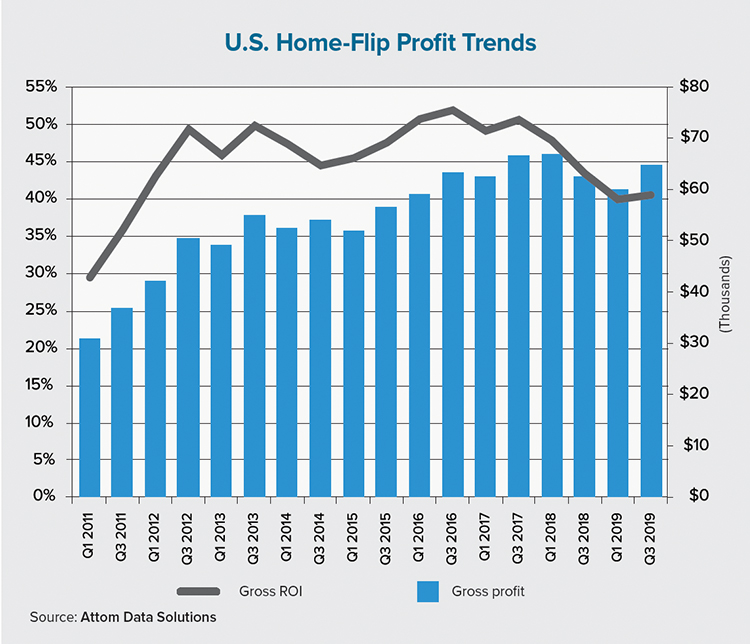In third-quarter 2019, there were 56,566 single- family homes and condominiums flipped nationwide, according to Attom Data Solutions’ U.S. Home Flipping Report. That number represents a 12.9% quarterly decline and a 6.8% annual decline. Last spring saw an unusually strong market for home flipping, so the declines in the past third quarter were an about-face, marking the largest quarterly and yearly decreases in five years.
The slowdown in the number of homes being flipped is likely related to a similar slowdown in profits from these sales. According to the National Association of Realtors, the nationwide median sales price for an existing home was $271,300 this past November, a 5.4% year-over-year increase and the 94th straight month of price increases.
Although rising sales prices are typically a good sign for the fix-and-flip market, they have been accompanied by corresponding increases in purchase prices for investors. The median purchase price of homes that were eventually flipped was $160,000 in the third quarter of last year, compared to $144,000 in third-quarter 2018, according to Attom Data.
The median sales price of these homes after improvements were made also increased during this time frame, from $206,700 in third-quarter 2018 to $224,900 in third-quarter 2019. The median gross profit of $64,900 in the past third quarter represents a 1.8% quarterly increase and a 3.5% annual increase.
Although these increases appear positive, the profits translate into a return on investment (ROI) of only 40.6% compared to the acquisition price. Second-quarter 2019 saw a median gross ROI of 41.1% for home flips, while the ROI in third-quarter 2018 was a more robust 43.5%. Fix-and-flip profits in the third quarter of last year were the second-lowest figure for any quarter since 2011, only slightly higher than the 40% ROI seen in first-quarter 2019.
These returns certainly pale in comparison to the post-recession peak of 52.1% seen in the second and third quarters of 2016. In the current market climate, diminishing returns are leading some investors to look to the rental market as an alternative to selling.
Any real estate investment, however, is highly dependent on location and, as usual, home-flip markets vary widely across the U.S. Home flips as a portion of all home sales decreased in third-quarter 2019 in 78% of the metropolitan statistical areas (MSAs) analyzed by Attom Data — or 115 out of 147 MSAs with a population of at least 200,000 and at least 50 home flips during the quarter.
Some areas of the country, however, are still seeing lively returns in their home-flipping markets. In fact, despite the nationwide trend of narrowing profit margins, eight MSAs had median gross ROI margins of at least 100%, meaning investors doubled their money in these markets. Pittsburgh led the country with an ROI of 132.6%, followed by Scranton, Pennsylvania (122.5%); Flint, Michigan (111.2%); Cleveland (109.8%); and Hickory-Lenoir-Morganton, North Carolina (109.7%).
On the other end of the spectrum, there were several areas that underperformed in terms of profits. Among the markets with a population of 1 million or more, the smallest median gross flipping profits occurred in Raleigh, North Carolina ($25,000). Austin ($27,549); Phoenix ($31,135); Las Vegas ($33,150); and Kansas City, Missouri ($39,141) rounded out the top five.
Although the fix-and-flip business remains viable in many areas, sales are slowing down and returning to more normal levels. According to Attom Data, the homes flipped in third-quarter 2019 represented only 5.4% of all home sales. That share represents a quarterly decline from 6% in second-quarter 2019, although it is a slight increase from the 5.2% share in third-quarter 2018.
Larger market forces are at play, making it more difficult for investors to identify the kinds of deals they were getting as recently as last year. It also is becoming harder for investors to earn the return on investment that they’d like. Market forces show no signs of easing, however, so these levels may be the status quo for the foreseeable future.
Author
-

Todd Teta is chief product and technology officer at Attom Data Solutions, where he leads the company’s technology and product teams. Prior to joining Attom Data Solutions, Teta led the product-development and technology organization at Meyers Research. Teta also previously co-founded several startups, including VisionCore, a company serving the mortgage and real estate data and analytics markets that was later sold to CoreLogic. He is a graduate of the University of Southern California, where he earned a degree in computer engineering and computer science. Learn more about Attom Data Solutions at attomdata.com.
View all posts







